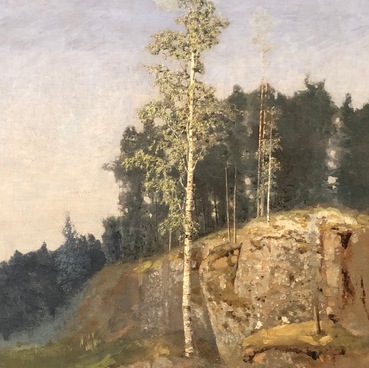Kharon Isayev painted the Bride in 1992. The artist created a generalized image of a modest mountaineer bride. In fact, his brother’s wife sat for him as a model. The young woman’s countenance is calm and noble. Her black hair is covered by a light transparent veil, which comes down her shoulders.
The artist scrupulously copied the minute details of her outfit. He depicted the young woman in the national ceremonial attire. Such swing dresses are called ‘gabali’. They are traditionally made of silk or other expensive fabrics. The gabali is worn above the bottom dress, and together they create a single ensemble.
Sixteen breast clasps come down from the collar to the waist. They are called ‘tuydargash’. These clasps are often made of gilded silver. Sometimes the items are decorated with precious stones and ornaments. The breast clasps are attached to the bottom dress to emphasize the costume’s basic solemnity. The dress is worn with a mandatory metal belt.
Kharon Isayev is a People’s Artist of the Chechen Republic and a member of the Russian Union of Artists. In 1973, he went to study at the I.E. Repin Academy of Arts in Leningrad, but for family reasons, he had to interrupt his studies. In 1975, the artist graduated from the Moscow Correspondence People’s University of Arts, majoring in easel painting and graphics. His first exhibition was held in 1982. Since that time, the artist has participated in various national and international exhibitions held in the southern region of Russia and in Moscow. The artist’s exhibitions in Jordan, Turkey and Syria have also been quite successful.
Kharon Isayev works in different genres. His portraits, landscapes and paintings on historical motifs convey the artist’s love for his people and his native land. His art upholds the traditions of realistic painting.
Before the war of the 1990s, the painting had been exhibited at the P.Z. Zakharov Republican Museum of Fine Arts. The museum was destroyed, but the picture was saved. It was taken to the I.E. Grabar Restoration Center in Moscow for conservation. In 2014, the Bride returned to Grozny.
The artist scrupulously copied the minute details of her outfit. He depicted the young woman in the national ceremonial attire. Such swing dresses are called ‘gabali’. They are traditionally made of silk or other expensive fabrics. The gabali is worn above the bottom dress, and together they create a single ensemble.
Sixteen breast clasps come down from the collar to the waist. They are called ‘tuydargash’. These clasps are often made of gilded silver. Sometimes the items are decorated with precious stones and ornaments. The breast clasps are attached to the bottom dress to emphasize the costume’s basic solemnity. The dress is worn with a mandatory metal belt.
Kharon Isayev is a People’s Artist of the Chechen Republic and a member of the Russian Union of Artists. In 1973, he went to study at the I.E. Repin Academy of Arts in Leningrad, but for family reasons, he had to interrupt his studies. In 1975, the artist graduated from the Moscow Correspondence People’s University of Arts, majoring in easel painting and graphics. His first exhibition was held in 1982. Since that time, the artist has participated in various national and international exhibitions held in the southern region of Russia and in Moscow. The artist’s exhibitions in Jordan, Turkey and Syria have also been quite successful.
Kharon Isayev works in different genres. His portraits, landscapes and paintings on historical motifs convey the artist’s love for his people and his native land. His art upholds the traditions of realistic painting.
Before the war of the 1990s, the painting had been exhibited at the P.Z. Zakharov Republican Museum of Fine Arts. The museum was destroyed, but the picture was saved. It was taken to the I.E. Grabar Restoration Center in Moscow for conservation. In 2014, the Bride returned to Grozny.



